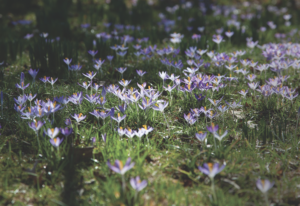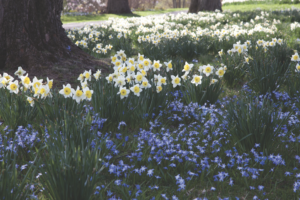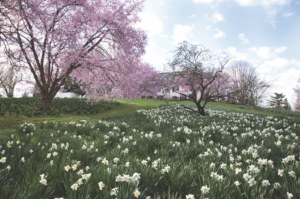Planting Impressionist Dreams of Bulbs
Create a picture perfect garden
Anyone who has ever marveled at carpets of winter aconites, snowflakes and daffodils can appreciate the beautiful ease with which bulbs brighten our spring gardens. Their colors are a punch-drunk tonic for winter-weary souls.
And it’s our bulb spectacles in spring and in autumn that draw visitors to Chanticleer and other majestic public gardens. From the ‘Actaea’ and ‘Ice Follies’ daffodils under the Japanese flowering cherries and crabapples in the Orchard to the surprise lilies (Lycoris x squamigera) and colchicums in the Bulb Meadow, bulbs bookend the blooming seasons.
Although bulb catalogs often use the terms naturalize and perennialize interchangeably, not understanding the distinction can affect your approach to planting bulbs. In addition, understanding these terms can shape your strategy in maintaining your bulbs’ longevity in future years.
Perennializing
 Perennialize means that bulbs are like perennial plants, returning year after year and increasing under ground. An easy way to under- stand the term is to look at your peonies or hostas and observe how the clump multiplies in size each year.
Perennialize means that bulbs are like perennial plants, returning year after year and increasing under ground. An easy way to under- stand the term is to look at your peonies or hostas and observe how the clump multiplies in size each year.
After some time, you can lift up the clump and divide it into sev- eral pieces for replanting elsewhere in the garden. These pieces retain the same characteristics—like flower color or variegated leaves—that make the plant desirable.
In fact, many plants like daffodils benefit from being divided when crowded. Overgrown clumps produce diminished flowering, even when in full sun. To rejuvenate such tired clumps, wait until the leaves begin to splay apart or start yellowing. Being clones, each bulb division will be alike.
But note if a perennializing bulb—like a named tulip or daffodil variety—produces seed, then its progeny will not be identical or true-to-type.
Naturalizing
 Naturalize means that bulbs will spread by seed as well as multiply underground. Like siblings in a family, these seedlings resemble their parents but with physical and genetic differences.
Naturalize means that bulbs will spread by seed as well as multiply underground. Like siblings in a family, these seedlings resemble their parents but with physical and genetic differences.
Because naturalizing bulbs tend to produce diminutive flowers, they need large numbers to make an impact. Fortunately they are inexpensive to buy, so creating a statement is not costly.
When choosing a planting location, consider that trees help keep the soil drier and weaken aggressive turf, making it thinner. Planting naturalizing bulbs under and along trees can help them spread through seeds.
Naturalizing bulbs tend to reward gardeners who have a laissez-faire attitude about their gardens. Time is the essential ingredient here. Left untended in ideal conditions, these bulbs increase more and more to create those stupendous displays that garden designers and home gardeners dream of.
Planted to Impress
Differentiating naturalizing and perennializing bulbs is not important when you’re planting in containers or en masse for a temporary display. But when the bulbs are used long-term to blend in with the existing planting or landscape, the difference may matter.
A simple solution to bridge both types of bulbs is to pay attention to scale. Naturalizing bulbs and their primary hybrids that perennialize have a wilder look than the more overbred perennializing bulbs. As an example, a large trumpet daffodil looks awkward among woodland spring wildflowers, compared with a miniature daffodil. The Gravel Garden at Chanticleer demonstrates how choosing bulbs of similar size and height can harmonize a planting vignette.
To create visual appeal, Chanticleer’s gardeners deliberately restrict colors and make discrete groupings that mimic nature. The bulbs are planted closely in the center and are feathered out at the edges of the grouping, like smoke curlicues or cirrus clouds.
The general advice for planting depth of bulbs is two to three times the height of the bulb. Note to novice gardeners: if you’re not sure which side is top or bottom, best to plant at an angle.
To Mow or Not to Mow …
 While companion plantings are designed to hide bulbs that are entering dormancy, the situation changes when perennializing and naturalizing bulbs are planted in turf.
While companion plantings are designed to hide bulbs that are entering dormancy, the situation changes when perennializing and naturalizing bulbs are planted in turf.
Because bulbs refuel from their foliage for their next flowering cycle, mowing your lawn before leaves are either close to yellowing or completely withered risks sacrificing the floral display next year. Delaying mowing allows naturalizing bulbs to ripen and disperse their seeds.
Although gardening references often suggest mowing about 5 to 6 weeks after flowering, it’s better to observe and take notes. Every site is different! At Chanticleer, mowing in the Orchard takes place in early to mid-June.
The grass may look rather unkempt for a short time, but it’s a small price to pay.
Stand Back and Evaluate
The advantage of perennializing and naturalizing bulbs is that over time the planting becomes more full. It may feel like slow progress, but as with many gardening projects, it’s best to relax and let the years take their course.
If the legwork for success is done, the bulbs will settle into their new places, eventually filling into a spectacle equal to an Impressionist painting.
Chanticleer is a garden of pleasure and learning, relaxing yet filled with ideas to take home. Visit in April through June to see spectacular bulb displays and to learn from the gardeners. The garden is open March 31 through October 31, Wednesday–Sunday, from 10 a.m. to 5 p.m. 786 Church Rd., Wayne. Visit ChanticleerGarden.org to plan your visit.
